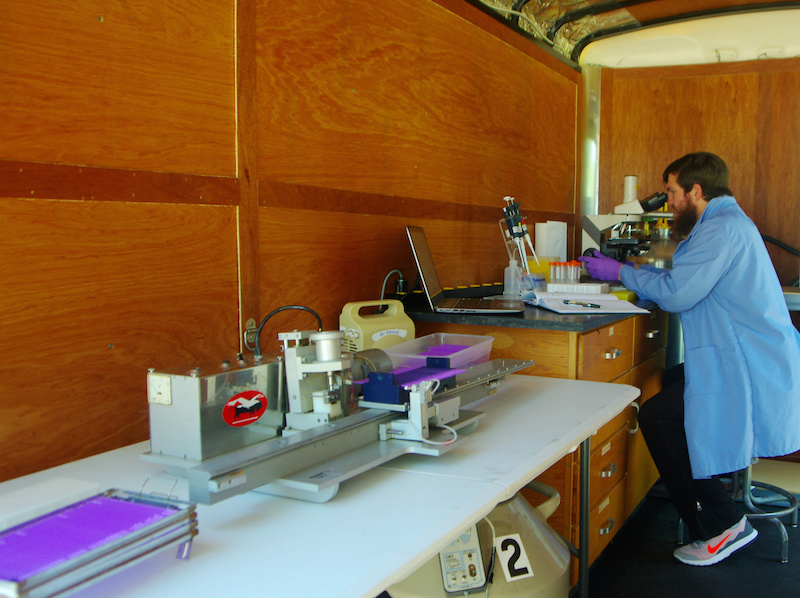
News & Views
New mobile cryopreservation lab to serve southern states
May 31, 2016 By Tom Walker
 The lab will handle high through-put with high quality
The lab will handle high through-put with high qualityA new mobile aquatic cryopreservation lab will help scientists at Louisiana State University better support industry, government and researchers.
“The problem has always been if you wanted to use cryopreserved germplasm (for genetic work) the scale was never there,” says Terrance Tiersch, Professor and Director of the Aquatic Germplasm and Genetic Resources Center (AGGRC) at Louisiana State. “You couldn’t preserve enough.”
Indeed he points out that some researchers may only have access to tens or hundreds of samples throughout their entire career. “The quality perhaps wasn’t there, so it wasn’t reliable,” he adds.
“Freezing material out in the field is not a new concept,” says Tiersch. “We have been freezing material on boats and on islands and on river banks for 25 years and so have many other people.”
The common practice of shipping fish to a center to be held for collection can cause stress, and shipping germplasm from a site to the center is limited by the small size of shipping dewars.
The AGGRC is moving to develop a commercial scale resource center and as such, they need capacity.
“We wanted to be able to handle high through-put with very high quality so that’s changed the rules, raised the bar,” says Tiersch. And that’s why they decided to put everything into a self-contained trailer.
Custom trailer
Graduate student Bill Childress who was in charge of the project says the trailer is nothing fancy. “We had it custom-designed for the size we needed, 12’ x 6 ’x 6’ and then I came in and pieced things together,” says Childress. “We went back and forth with people in the lab to see how things worked and then we would take it on the road, see a flaw, and change it.”
The regular axel rating of 1200 lbs. is sufficient, says Childress. “The heaviest thing would be the nitrogen tank.” He can load and unload all of the equipment himself, with the help of a dolly.
“Normally if we travel somewhere and set up in their lab, we can have everything unloaded and ready to go in 30 minutes,” says Childress.
Three scenarios
Setting up in a client’s own lab is one of three scenarios that the mobile lab can serve, Childress explains. The lab can also stay self-contained and be plugged into the client’s power source on site, or it can run off a generator for work in the field.
The generator puts out 5500 watts and can run for 10 hours on seven gallons of fuel. “We are able to run the air conditioner, lights, microscope, automated straw filler, and programmable freezer at the same time,” says Childress. “We don’t have to worry about being bogged down running one piece of equipment and not the other.” All equipment was purchased stock from suppliers. With the available computer control, the mobile lab can fill, seal and freeze thousands of straws an hour.
Quality control
A counting chamber mounted on a microscope allows them to asses initial motility and concentration of samples. “Quality control and everything that normally gets done in the lab, can be done out there in the mobile trailer,” says Childress.
The lab is working with user groups in Arkansas, Louisiana, Texas and Mississippi and looking for additional collaborations. They are not at present charging for their services.
Childress says they have cooperators that they currently have grants with or that they have worked with in the past.
“We have worked with 10 different species in the Genus Xiphophorus, plus blue catfish (Ictalurus furcatus), red snapper (Lutjanus campechanus), Atlantic croaker (Micropogonias undulates), and eastern oyster (Crassostrea virginica),” he says.
“Those species represent user groups in the biomedical, aquaculture, and fishery fields. In the future we would like to see the mobile laboratory grow into a service for all user groups, whether it is aquaculture, biomedical, fisheries, imperiled species, or any other group, and develop a wide-ranging clientele to serve.”
“I think our partners have liked us coming there,” adds Childress. “They can see the whole operation along with their normal working procedures. We can usually get a bit more done in a shorter period of time.”
— Tom Walker
Print this page





